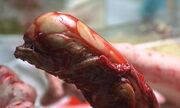| This page is similar in name or subject to other pages.
See also Alien for a complete list of references to clarify differences between these closely named or closely related articles. |
- "You still don't understand what you're dealing with, do you? Perfect organism. Its structural perfection is matched only by its hostility."
- ―Ash
| Xenomorphs | |
|---|---|
| Xenomorphs | |
| Aliases: | Aliens |
| Sub-groups: | Queens; Warriors; Drones; Facehuggers; Chestbursters |
| Films: | Alien; Aliens; Alien³; Alien Resurrection; Alien vs. Predator; Aliens vs. Predator: Requiem |
| Programs: | None |
| 1st appearance: | Alien (1979) |
Xenomorph is actually a general phrase which refers to any foreign or extraterrestrial organism that possesses anthropomorphic properties. Classically, the term has been applied to one specific parasitic breed of insectoid animal that can adapt the physical characteristics of its host form. Xenomorph eggs produce an crab-like embryo commonly referred to as a "facehugger", which impregnates human hosts with its larva, which eventually give birth to true xenomorphs.
History[]
The origin of the species as well as that of their home world is subject to speculation, but the existence of these creatures can be traced back several thousand years. A predatory alien race known as the Yautja found that xenomorphs made excellent hunting prey and used them for sport as well as rites of passage for their young warriors. The historical record shows that a Yautja expedition came to Earth millennia ago and brought with them embryonic xenomorphs, which they housed inside of a pyramid on Bouvet Island off the coast of Antarctica. They captured primitive humans and used them as sacrificial hosts for the xenomorph facehuggers, giving birth to the "ultimate prey". [1]
Biology[]
- "It's got a wonderful defense mechanism. You don't dare kill it."
- ―J.T. Parker
Xenomorphs are insectoid endoparasites ranging in height between seven feet to fifteen feet tall. Their exoskeleton consists of a highly durable silicon shell, which develops after a short molting period in which the xenomorph sheds its skin. Traditionally, they have two arms, two legs, an elongated head and a secondary mandible housed within their mouth that juts out in a stabbing motion for attacking prey. A xenomorph circuliatory system consists of concentrated acid in place of blood, making them one of the most dangerous exterrestrial species in existence.
Society[]
SECTION NOT YET WRITTEN.
Life Cycle[]
The life cycle of a xenomorph is very complex and consists of four stages of growth. These stages include Queen, Egg, Facehugger, Chestburster, Adult.
Queen[]
SECTION NOT YET WRITTEN.
Facehugger[]

Kane's facehugger
A "facehugger" is the first stage in a newborn xenomorph's life cycle. At birth, this entity is an arthropod with eight jointed appendages, external lung bladders, a long tail and a probiscus which is used for human fertilization. A facehugger remains in its egg until such time that suitable prey comes within proximity of the egg at which point the lobes of the egg open and the Facehugger propels itself forward, latching onto its prey. It attaches itself to a victim's face, and renders the target unconscious by wrapping its tail about their throat, depriving them of oxygen. It inserts its proboscis into the victim's mouth, implanting them with an embryo while meanwhile supplying them with oxygen. Once the facehugger serves its function, it detaches itself from the host and dies shortly thereafter. Like the adult xenomorphs, facehuggers also have concentrated acid for blood and are extremely difficult to kill.
Chestburster[]

A chestburster
The incubation period of a xenomorph embryo varies, but usually occurs within the span of only a few hours. The host awakens shortly after separating from the facehugger with little memory of the experience and marginal symptoms of the alien infection. The newborn grows inside the chest of a human host, behind the ribcage, until such time that it is capable of functioning independently. At this point, it violently explodes from the host, exiting the body through the ribs giving rise to the term "chestburster". The size and physical characteristics of a chestburster vary depending upon the physiology of the host. A human host will yield a chestburster that is approximately one foot in height and bipedal. A quadraped host will yield a much larger chestburster (proportionate to the size of the host), with a curved spine and four legs. A Yautja chestburster, or "Predalien", is born with a bifarcated jaw, similar to its host's anatomy.
Adult[]
SECTION NOT YET WRITTEN.
Notes & Trivia[]
- The appearance of the Xenomorph was designed by Swiss artist H.R. Giger.
- The life cycle of the Xenomorph's birth cycle was inspired by spider wasps, which are said to lay their eggs inside the abdomen of spiders. Screen writer Dan O'Bannon took this concept and incorporated it into his original script for Alien. [2]
Parodies[]
- In the "Epidemiology" episode of the TV sit-com Community, two of the main characters dressed up as characters from Aliens for their school's Halloween party. Abed Nadir dressed up as a Xenomorph and Troy Barnes created his own Loader costume - the same device that Ellen Ripley used to fight the alien Queen.
See also[]
External Links[]
- Xenomorphs at Wikipedia
- Xenomorphs at Xenopedia
- Xenomorphs at the Holosuite
- Xenomorphs at the Dark Horse Database
References[]
- ↑ Alien vs. Predator (2004)
- ↑ Dan O'Bannon; Alien Special Edition; Aliens Quadrology; 2003
| This article relates to the Aliens film franchise. |
| Something is definitely missing here!
One or more sections of this article is incomplete, and requires additional information to bring this article to a higher standard of quality. You can help Headhunter's Horror House Wiki by editing this page, provide missing information or improve outdated sections. |
